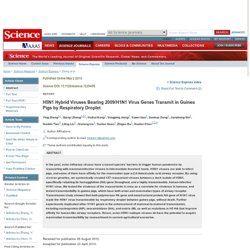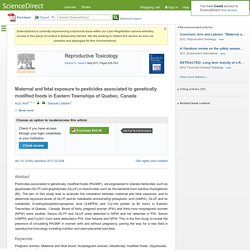

H5N1 Hybrid Viruses Bearing 2009/H1N1 Virus Genes Transmit in Guinea Pigs by Respiratory Droplet. In the past, avian influenza viruses have crossed species’ barriers to trigger human pandemics by reassorting with mammal-infective viruses in intermediate livestock hosts.

H5N1 viruses are able to infect pigs, and some of them have affinity for the mammalian type α-2,6-linked sialic acid airway receptor. By using reverse genetics, we systemically created 127 reassortant viruses between a duck isolate of H5N1, specifically retaining its hemagglutinin (HA) gene throughout, and a highly transmissible, human-infective H1N1 virus.
We tested the virulence of the reassortants in mice as a correlate for virulence in humans, and tested transmissibility in guinea pigs, which have both avian and mammalian types of airway receptor. Transmission study showed that both polymerase PA gene and nonstructural protein NS gene of H1N1 virus made the H5N1 virus transmissible by respiratory droplet between guinea pigs, without death. Genetic-programming.com-Home-Page. Picri OGM. Testbiotech. CRIIGEN - Accueil. Analyse: Le débat sur « l’affaire Monsanto » met en lumière la souveraineté des semences. L’agriculture est l’un des moteurs de l’économie népalaise, mais on ne peut pas en dire autant de son programme de recherche KATMANDOU, 11 janvier 2012 (IRIN) - La société civile s’oppose à la mise en œuvre d’un projet de partenariat entre les bailleurs de fonds américains, la multinationale agroalimentaire Monsanto et le gouvernement népalais, et dont l’objectif est de stimuler la production locale de maïs en utilisant des semences hybrides importées.

Elle appelle plutôt à la recherche de solutions « maison ». « Si une organisation comme l’USAID [Agence des États-Unis pour le développement international] veut s’associer à une entreprise comme Monsanto pour nous épauler, elle pourrait au moins nous aider à développer nos propres variétés hybrides au lieu d’importer des semences étrangères », a dit Hari Dahal, porte-parole du ministère de l’Agriculture et des Coopératives, lors d’un récent débat parlementaire sur la souveraineté alimentaire.
Une entrée peu remarquée Agir par nous-mêmes. Reproductive Toxicology : Maternal and fetal exposure to pesticides associated to genetically modified foods in Eastern Townships of Quebec, Canada. A Department of Obstetrics and Gynecology, University of Sherbrooke Hospital Centre, Sherbrooke, Quebec, Canadab Clinical Research Centre of Sherbrooke University Hospital Centre, Sherbrooke, Quebec, Canadac Faculty of Medicine and Health Sciences, University of Sherbrooke, Sherbrooke, Quebec, Canada Received 29 June 2010, Revised 26 January 2011, Accepted 13 February 2011, Available online 18 February 2011 Choose an option to locate/access this article: Check if you have access through your login credentials or your institution Check access doi:10.1016/j.reprotox.2011.02.004 Get rights and content Abstract Pesticides associated to genetically modified foods (PAGMF), are engineered to tolerate herbicides such as glyphosate (GLYP) and gluphosinate (GLUF) or insecticides such as the bacterial toxin bacillus thuringiensis (Bt).

Keywords Pregnant women; Maternal and fetal blood; Nonpregnant women; Genetically modified foods; Glyphosate; Gluphosinate; Cry1Ab Copyright © 2011 Elsevier Inc.